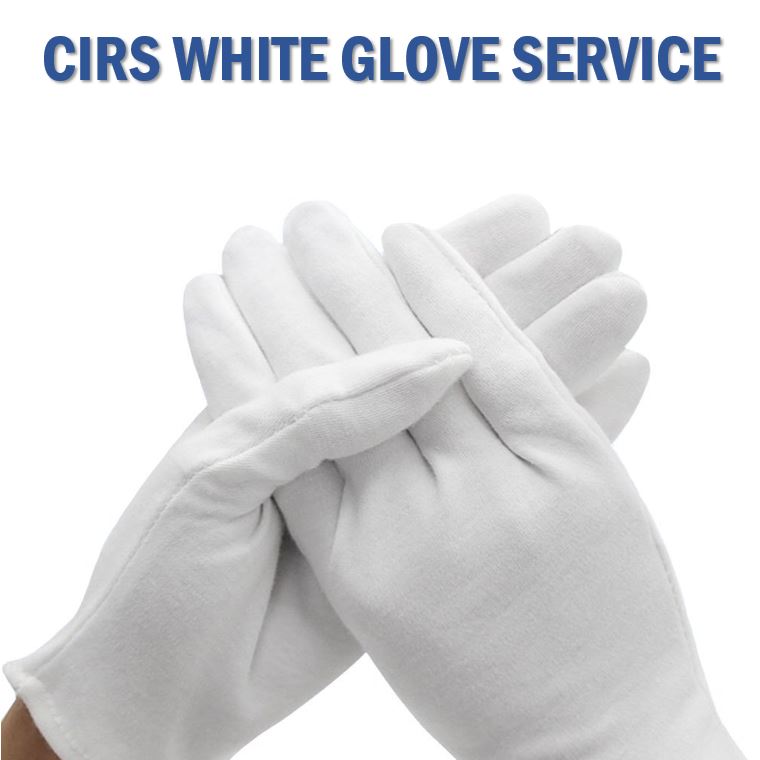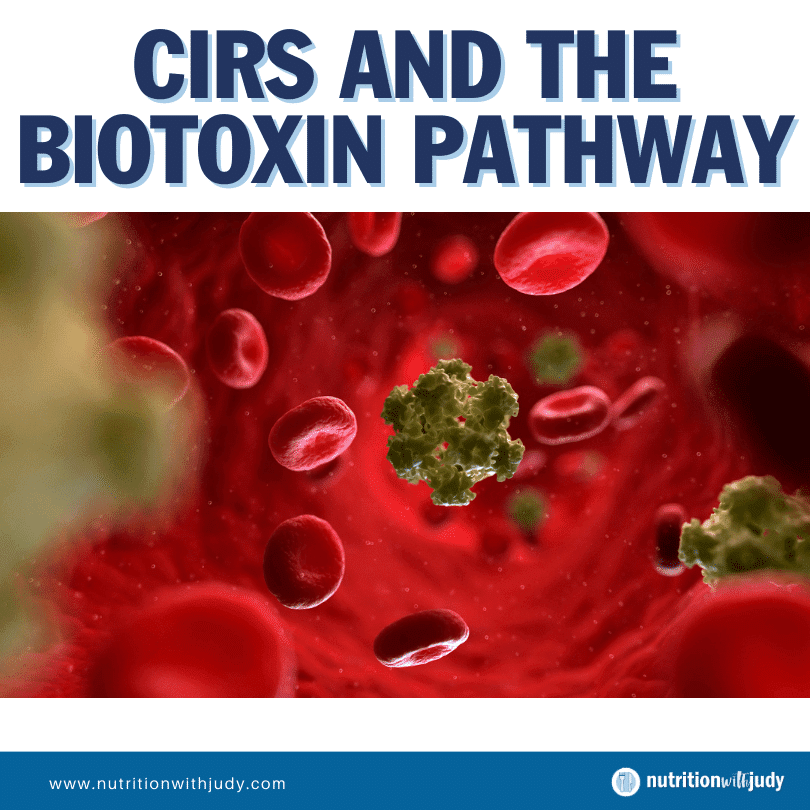

CIRS and the Biotoxin Pathway


Understanding the intricate relationship between Chronic Inflammatory Response Syndrome (CIRS) and the biotoxin pathway is important for anyone exploring this complex health condition.
CIRS, a multi-system, multi-symptom chronic illness, arises when the immune system is unable to detox biotoxins on its own, leading to a cascade of systemic reactions. The biotoxin pathway plays a central role in this process, dictating how biotoxins trigger immune responses and subsequently affect various bodily systems.
By taking a closer look into the mechanics of this pathway, we can gain essential insight into the multifaceted nature of CIRS, providing a foundation for understanding its extensive impact, the various downstream symptoms, and why it manifests differently across all patients.
What Is CIRS?
Chronic Inflammatory Response Syndrome (CIRS) is a complex condition characterized by widespread inflammation and a wide scope of symptoms across multiple systems, stemming from an excessively reactive immune system. Recognized as a valid medical condition, CIRS necessitates precise laboratory tests and a thorough examination of the patient’s history for accurate identification. The variability in symptoms among individuals often leads to misdiagnosis or lack of treatment. Contrary to other immune disorders marked by maladaptive adaptive immune responses, CIRS cannot be pinpointed through standard autoimmune blood tests.
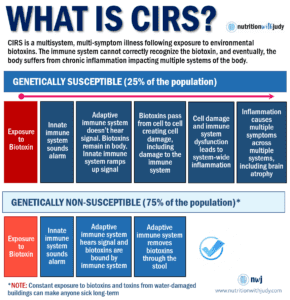

What triggers this hyperactive immune reaction and pervasive inflammation? The answer lies in biotoxins– toxic substances of biological origin with a certain molecular weight. Biotoxins are the primary culprits behind CIRS, arising from various sources:
- Water-damaged buildings: Around 80% of CIRS cases are linked to the inhalation of air from water-damaged buildings, teeming with a mix of mold mycotoxins, bacteria, and other chemical irritants. These elements induce an inflammatory reaction in those predisposed to CIRS, with both live and dead mold particles capable of igniting extensive inflammation in the body and brain.
- Bites from ticks or spiders: Infections from specific tick bites can evolve into chronic Lyme disease, caused by organisms such as Borrelia burgdorferi and Babesia microti. Similarly, biotoxins from spider bites, especially those from recluse spiders, may have long-lasting effects.
- Seafood consumption: Eating tropical reef fish contaminated with ciguatera toxin, produced by Pfiesteria and associated with harmful algae blooms and cyanobacteria (blue-green algae), can result in biotoxin-related illnesses. These toxins accumulate as reef fish consume smaller fish infected with dinoflagellates.
- Contaminated water exposure: Direct contact or inhalation of water contaminated with algae blooms (Pfiesteria) and cyanobacteria can trigger the inflammatory response seen in CIRS sufferers.
- Other biotoxin sources: Additional triggers for CIRS include exposure to certain vaccines, volatile organic compounds (VOCs), endotoxins, and actinomycetes.
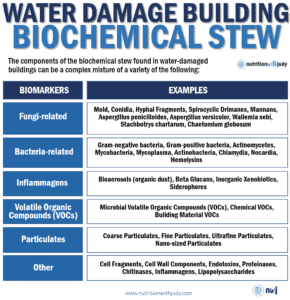

Due to their microscopic molecular size, biotoxins can traverse cellular membranes, making them nearly undetectable in routine blood tests. These toxins primarily enter the body through breathing but can also be absorbed through ingestion, bites from ticks and spiders, and direct contact with water contaminants.
Although encounters with common biotoxins like mold do not invariably lead to CIRS in everyone, a combination of genetic predisposition and traumatic experiences significantly influences the risk of developing biotoxin-related illnesses. Events such as severe stress, illnesses, surgeries, high fevers, pregnancies, substantial biotoxin exposure, and other traumatic incidents can initiate a cytokine storm. This, in turn, may activate the CIRS gene in individuals inherently at risk due to their genetic makeup (specifically those with HLA-DR genes), indicating that CIRS can emerge at any stage of life. Importantly, the absence of symptoms does not guarantee immunity, and genetic testing can provide valuable preventive insights.
While biotoxins might lead to acute illness, the immune systems of most individuals can identify and effectively eliminate these toxins. However, in people with genetic susceptibility to CIRS, their immune systems fail to recognize and dispose of these biotoxins, resulting in their indefinite circulation within the body. This accumulation triggers an excessive immune reaction and widespread inflammation, culminating in a variety of symptoms and health issues.
You can learn more in-depth about CIRS here.
The Biotoxin Pathway
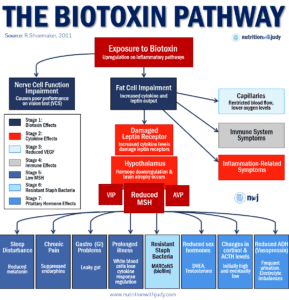

The biotoxin pathway delineates the cascade of reactions triggered by CIRS and its impact on a weakened immune system:
Phase 1: Biotoxin Impact
The journey begins with exposure to a biotoxin in individuals prone to genetic susceptibility. In the general population, these biotoxins are usually recognized, marked by the immune system, broken down, and then eliminated from the body through the liver’s detoxification processes.
However, for those lacking specific immune response genes, namely HLA-DR genes, their immune system fails to produce the necessary antibodies to recognize the foreign antigen. Consequently, biotoxins remain circulating within the body indefinitely, causing systemic disruptions.
Upon entering the systems of these genetically predisposed individuals, biotoxins initiate a series of complex biochemical reactions. They attach to the surface receptors of nearly every cell type, instigating a persistent activation of various inflammatory pathways, including the production of cytokines.
Biotoxins directly impair nerve function and provoke widespread, chronic inflammation throughout the body.
Phase 2: The Role of Cytokines
Cytokines are critical proteins that serve as essential regulators of inflammation within the body. In a functioning immune system, they respond to pathogens by facilitating the enhancement of inflammatory reactions.
In the context of CIRS, the immune system’s failure to recognize and eliminate biotoxins, and to produce antibodies accordingly, leads to cytokines attaching to their receptors. This interaction triggers the release of Matrix Metalloproteinase-9 (MMP-9) into the bloodstream. MMP-9 plays a role in moving inflammatory components from the blood into delicate tissues, potentially exacerbating issues like impaired circulation and the formation of clots.
Regarding brain health, cytokines interfere with leptin receptors, disrupting their normal operations and diminishing the secretion of melanocyte-stimulating hormone (MSH). Leptin receptors are crucial for metabolic regulation, immunity, and reproductive health. The initial signs stemming from elevated cytokine levels often manifest as concentration difficulties, fluctuating body temperatures, headaches, and muscular pains.
A critical point to note from the effects of cytokines is the resulting deficiency in MSH, a topic that will be explored more thoroughly in the fifth stage.
Stage 3: Decreased VEGF
When cytokine levels rise in the bloodstream, they draw white blood cells, which in turn limit blood circulation, decrease tissue oxygenation, and diminish levels of vascular endothelial growth factor (VEGF). VEGF acts as a crucial signal protein that stimulates the formation of new blood vessels and is vital for re-establishing blood flow to cells and tissues that are oxygen-deprived. The reduction in VEGF can cause various symptoms, including muscle spasms, fatigue, breathlessness, and a decreased capacity for physical activity.
Stage 4: Effects On the Immune System
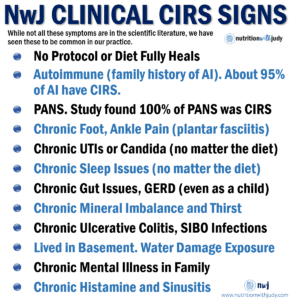

By the fourth stage, individuals possessing specific HLA genes related to immunity may exhibit further maladaptive immune responses. These can manifest as autoimmune disorders, gluten intolerance, and anomalies in blood clotting. Observations include patients developing conditions such as multiple sclerosis (MS), ulcerative colitis, and various other autoimmune diseases as a result of CIRS.
In every case of CIRS, there’s a continuous activation of the complement system. This component of the immune system, also referred to as the complement cascade, plays a crucial role in boosting the effectiveness of antibodies to clear out damaged cells, eliminate microbes, induce inflammation, and neutralize pathogens. The persistent activation of the complement system leads to unchecked inflammation affecting every bodily system, including the brain, and results in elevated levels of C4a, an anaphylatoxin that stimulates inflammatory immune responses.
The culmination of heightened cytokine levels, increased MMP9 in the bloodstream, diminished VEGF, and reduced MSH levels can precipitate “leaky junctions” within the blood-brain barrier and the intestinal lining. This “leaky brain” scenario facilitates the entry of neuropathic toxins into the brain, causing significant inflammation and disrupting the functions of the pituitary and hypothalamus glands.
Stage 5: Decreased MSH Levels
Melanocyte-stimulating hormone (MSH) plays an indispensable role in hormone regulation, immune functionality, and controlling inflammation. It’s noted that over 95% of individuals with CIRS exhibit low levels of MSH. This decline in MSH, combined with the presence of particular immunity-related HLA genes (as covered in phase four), accounts for the wide range of symptoms experienced by each person suffering from CIRS.
A reduction in MSH leads to lower melanin production, which manifests as chronic fatigue and disrupted, non-restorative sleep patterns. Additionally, it results in diminished endorphin levels, thereby causing persistent pain. The “leaky junctions,” exacerbated by insufficient MSH, further contribute to the development of leaky gut syndrome. This condition is associated with autoimmune diseases and further compromises and deregulates the immune system’s functionality. Consequently, white blood cells exhibit an impaired cytokine response, increasing vulnerability to opportunistic infections and prolonging recovery periods.
Stage 6: Resilience of Antibiotic-Resistant Staph Bacteria
A subsequent consequence of diminished MSH levels is the ability for antibiotic-resistant staph bacteria, referred to as MARCoNS, to persist within the nasal cavity’s biofilm. Present in more than 80% of individuals with CIRS who have low MSH, MARCoNS thrives due to the “leaky junctions” condition. These bacteria secrete toxins that degrade MSH levels even more, intensifying the array of symptoms experienced by those affected.
Stage 7: Impact On Pituitary Hormones
The final consequence of diminished MSH involves a decrease in the pituitary gland’s production of antidiuretic hormone (ADH). Approximately 80% of individuals suffering from CIRS experience disrupted ADH/osmolality levels. The manifestations of this imbalance include frequent urination, excessive thirst, reduced blood volume, lowered blood pressure, and experiences of static electricity shocks.
Additionally, the production of sex hormones is typically suppressed, whereas the pituitary gland might increase the secretion of adrenocorticotropic hormone (ACTH) and cortisol. As the condition advances, the pituitary gland’s activity may significantly decline, resulting in very low or barely within normal ranges.
You can learn more about all the symptoms of CIRS here.
Pro-Tip: Are you an existing CIRS patient looking for additional support or primary care for your healing journey? Work with our renowned team one-on-one with our CIRS Support Package.
Closing Thoughts On CIRS and the Biotoxin Pathway
The biotoxin pathway shows us how CIRS can cause problems across the entire body. It starts when certain people, who are more likely to get sick because of their genes, come into contact with harmful toxins.
This pathway maps out how these toxins sneak past the body’s defenses, leading to widespread inflammation, maladapted immune responses, and various symptoms affecting many parts of the body. From the immune system not being able to fight off these toxins, to problems with important body proteins, reduced growth factors, hormone imbalances, and even infections from tough bacteria, each step shows just how complicated and serious CIRS is.
Due to the nature of interconnected issues presented by CIRS that affect everything from hormones and nerve function to how well the immune system works, it’s no wonder so many people are misdiagnosed.
Understanding the biotoxin pathway helps us see why CIRS causes so many different symptoms and stresses the need for a thorough approach to treating it. It’s clear that tackling CIRS effectively means looking at it as a problem that affects the whole body, not just one part.


Pro-Tip: Are you looking for practitioner resources and a like-minded community to support you through your CIRS journey? Join our exclusive CIRS Support Group for the latest research, step-by-step protocol tools, and support to successfully achieve root-cause healing.
Work With Our Trusted CIRS Practitioners
The Nutrition with Judy practice is honored to be trusted CIRS practitioners having served hundreds of clients and patients from around the globe. We’re passionate about helping our clients achieve root-cause healing in order to lead the best quality of life possible that’s nearly symptom-free. Our team is dedicated to helping CIRS patients navigate this complex illness. If you think you’re suffering from CIRS, start with our White Glove Service for comprehensive care.
Start your root-cause healing journey today and contact us any time with any questions or concerns.
DISCLAIMER: This content is for educational purposes only. While we are board-certified in holistic nutrition and are nutritional therapy practitioners, we are not providing medical advice. Whenever you start a new diet or protocol, always consult with your trusted practitioner first.


